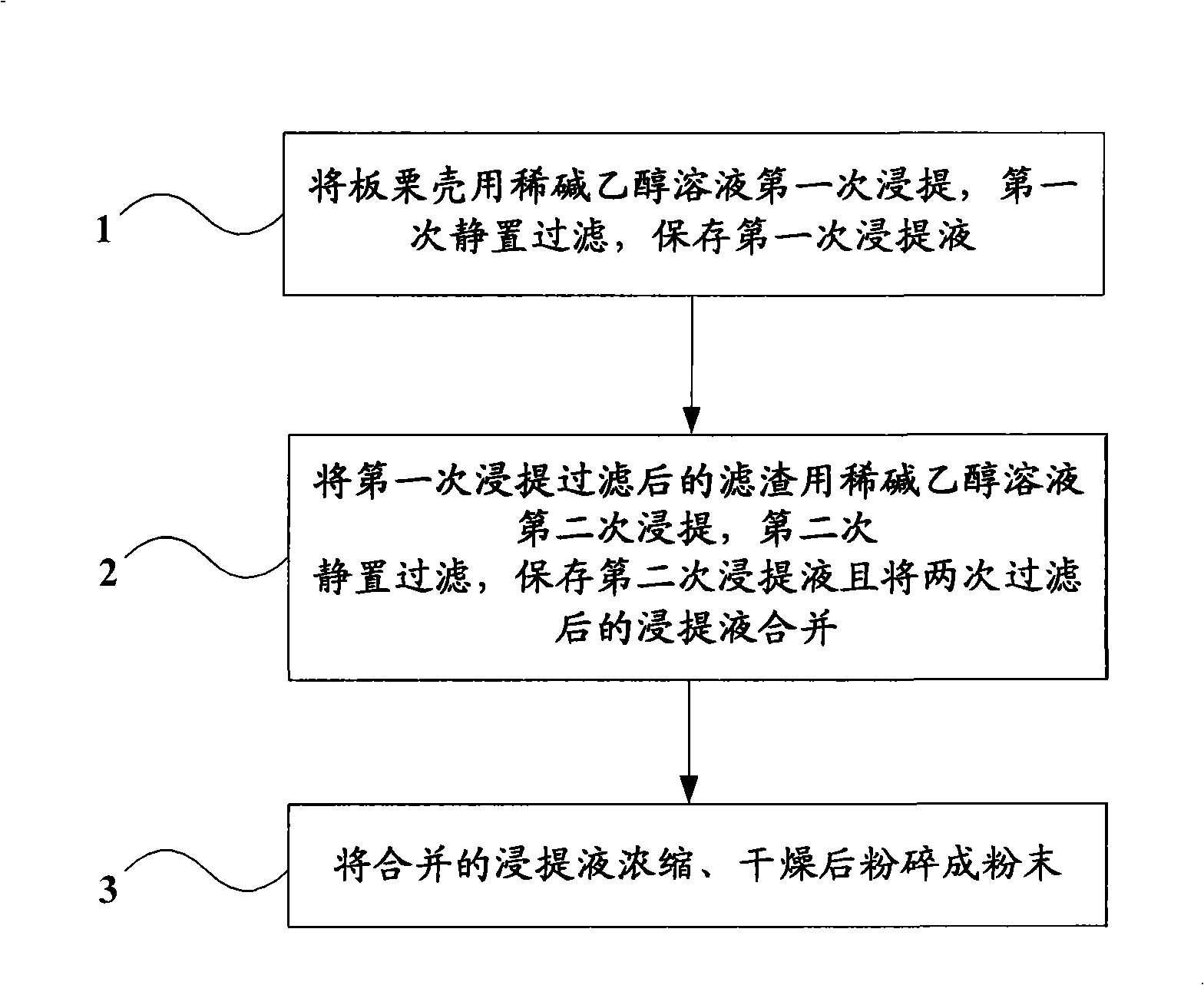Method for extracting chestnut shell brown pigment
An extraction method and technology of chestnut shells, which are applied in the field of extraction of brown pigment from chestnut shells, can solve the problems of poor water solubility of crude extracts, high concentration of lye, and complex processes, and achieve good water solubility, low cost, and simple extraction processes Effect
- Summary
- Abstract
- Description
- Claims
- Application Information
AI Technical Summary
Problems solved by technology
Method used
Image
Examples
Embodiment 1
[0034] Chestnut shells crushed to 60 meshes and dilute alkali ethanol solution (30% ethanol; pH=8) are extracted for the first time at a weight-to-volume ratio of 1:10, heated at 70°C for 4 hours, and left to stand for the first time After 1 hour, filter and save the first extraction solution; filter the filter residue after the first extraction and dilute alkali ethanol solution (30% ethanol; pH=8) according to the ratio of 1:7 by weight to volume, and carry out the second extraction. For the second extraction, heat at 70°C for 2 hours, filter after standing for the second time for 3 hours, save the second extract, and combine the two filtered extracts; put the combined extract at 60°C Concentrate by rotary evaporation at 60°C, then vacuum-dry at 60°C to make the water content by weight 10%, and finally pulverize into a powder with a fineness of 60 meshes.
Embodiment 2
[0036] Chestnut shells crushed to 80 meshes and dilute alkali-ethanol solution (40% ethanol; pH=8.5) are extracted for the first time at a weight-to-volume ratio of 1:15, heated at 75°C for 3 hours, and left to stand for the first time After 2 hours, filter and save the first extraction solution; filter the filter residue after the first extraction and dilute alkali ethanol solution (40% ethanol; pH=8.5) according to the ratio of 1:6 by weight to volume, and carry out the second extraction. For the second extraction, heat at 75°C for 3 hours, filter after standing for 2 hours for the second time, save the second extraction solution, and combine the two filtered extraction solutions; put the combined extraction solution at 60°C Concentrate by rotary evaporation at 70°C, then vacuum-dry at 70°C to make the water content by weight 9%, and finally pulverize into a powder with a fineness of 70 meshes.
Embodiment 3
[0038] Chestnut shells crushed to 40 meshes and dilute alkali ethanol solution (50% ethanol; pH=9) are extracted for the first time at a weight-to-volume ratio of 1:20, heated at 80°C for 2 hours, and left to stand for the first time After 3 hours, filter and save the first extraction solution; filter the filter residue after the first extraction and dilute alkali ethanol solution (50% ethanol; pH=9) according to the ratio of 1:5 by weight to volume, and carry out the second extraction. For the second extraction, heat at 80°C for 4 hours, filter after the second standing still for 1 hour, save the second extraction solution, and combine the two filtered extraction solutions; put the combined extraction solution at 60°C Concentrate by rotary evaporation at 75°C, then vacuum-dry at 75°C to make the water content by weight 8%, and finally pulverize into a powder with a fineness of 80 meshes.
PUM
 Login to View More
Login to View More Abstract
Description
Claims
Application Information
 Login to View More
Login to View More - R&D
- Intellectual Property
- Life Sciences
- Materials
- Tech Scout
- Unparalleled Data Quality
- Higher Quality Content
- 60% Fewer Hallucinations
Browse by: Latest US Patents, China's latest patents, Technical Efficacy Thesaurus, Application Domain, Technology Topic, Popular Technical Reports.
© 2025 PatSnap. All rights reserved.Legal|Privacy policy|Modern Slavery Act Transparency Statement|Sitemap|About US| Contact US: help@patsnap.com

